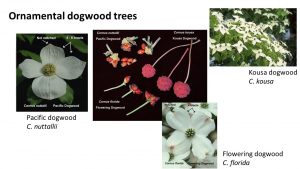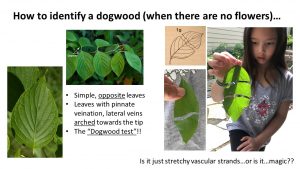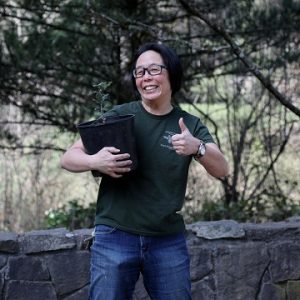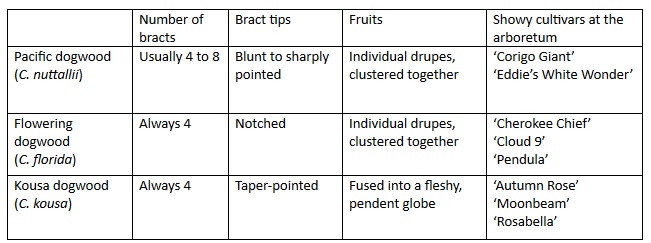Late spring is a perfect time to visit Hoyt Arboretum to see many of our glorious dogwoods! The Arboretum has over 70 different species, varieties, or cultivars of dogwoods, with most of them located in the Dogwood Section along the north end and back edge of the Vietnam Veterans Memorial.
First off, what is a dogwood?
A dogwood is any plant in the genus Cornus within the Cornaceae (dogwood family). The common name of dogwood may have come from the fruit being edible, but not fit for eating for even a dog (really?), and/or the name could have come from the use of its wood for pointed skewers or dags, which may have led to the term dagwood or dogwood. Nevertheless, dogwoods can be beautiful herbs, shrubs, or trees, and most people recognize dogwoods by their large, showy bracts which are often mistaken for petals…what?
Confusion about dogwood flowers!?
One of the most confounding features about dogwoods are their flowers! Many people see dogwoods in all their flowering glory and assume that they are seeing large flowers with 4 to 8 white or pink petals. However, what they are truly seeing is a “pseudanthium” (a false flower), where a cluster of small flowers forms what appears to be a single flower, and the large showy “petals” are actually involucral bracts (essentially a whorl of modified leaves) that have the appearance of flower petals! These bracts likely function to attract insect pollinators, as well as to protect the actual flowers.


Flower morphology
So what makes a dogwood specifically a dogwood (in the genus Cornus)? Almost all dogwoods have these shared features:
- Oppositely-arranged, simple leaves
- Leaves with pinnate, arcuate veination (which means that the secondary lateral leaf veins curve towards the tip before the leaf edges)
- Flowers in parts of 4’s: Sepals fused into a calyx of 4 lobes, 4 unfused petals, 4 stamens
- Flowers with an inferior ovary, often with a nectar disk
- Fruits that are juicy drupes (fleshy with a hard pit); may be fused together or not


Types of dogwoods
At Hoyt Arboretum, we have many different species of dogwoods, and they may be herbs, shrubs or trees. They may also be broadly lumped into the following recognizable groups:
- Flowers before leaves, no showy bracts. When plants flower before the leaves emerge in early spring, they are called “precocious” plants! At the Arboretum, look for Cornelian cherry (Cornus mas), or Japanese cornel (C. officinalis) in very early spring. In late summer, these will produce bright, orange-red, elongate, pendent juicy fruits.
- Flowers with the leaves, without showy bracts. These are often our shrubby dogwoods with colorful, striking stems. See our native red osier dogwood (Cornus sericea) and other shrub species including C. alba, C. alternifolia, C. amomum, C. racemosa, and C. sanguinea.
- Flowers with the leaves, with showy bracts. These include our native Pacific dogwood (C. nuttallii), as well as most of our attractive ornamental trees flowering dogwood (C. florida) and Kousa or Oriental dogwood (C. kousa).


Pacific Northwest natives
Looking for a few natives for your home garden? Dogwoods are super showy, relatively easy to grow, and natives can also provide habitat and food for wildlife. Our natives can be herbs, shrubs or trees! Bunchberry (either C. unalaschkensis or C. canadensis) is a low-growing herb that is common in forest understories in both the coast range and in the Cascades and does well in shaded areas. Red osier dogwood (C. sericea, synonym C. stolonifera) is often planted in riparian restoration sites and has bright red stems that are especially attractive in winter. Pacific dogwood (C. nuttallii) is a tree that often occurs in forest openings. Apparently, the straight species does not do very well in garden settings, but there are several cultivars of this native that survives well in gardens.


Pretty ornamental trees
Impressive ornamental dogwood trees are usually cultivars of Cornus florida, C. kousa, or C. nuttalii. These can be distinguished from one another by the shape and number of their involucral bracts and by their fruits.


A fun and easy way to identify dogwoods without flowers – the “Dogwood test”!!
Finally, here is a fun factoid for how to easily identify dogwoods by their leaves alone! In addition to looking at those leaf features (mentioned above), you can also do a “Dogwood test”, which is almost like doing magic!
Dogwoods have sticky and stretchy vascular bundles (veins) in their leaves, so when a leaf blade is carefully torn in two or more segments and gently pulled-apart (but not too far), the main veins will remain connected by delicate threads. This is a fun trick to show both kids and adults. I have not heard of any other plants that can do this (although there probably are), nor am I sure that all dogwoods can do this…but all of the ones that I have tried the “Dogwood test” on have passed!


Images & Diagrams from:
Michael Drewry (Hoyt Arboretum)
Oregon Flora Project Photo Gallery
Zomlefer, W.B. 1994. Guide to Flowering Plant Families. UNC Press, Chapel Hill.
About the Author



